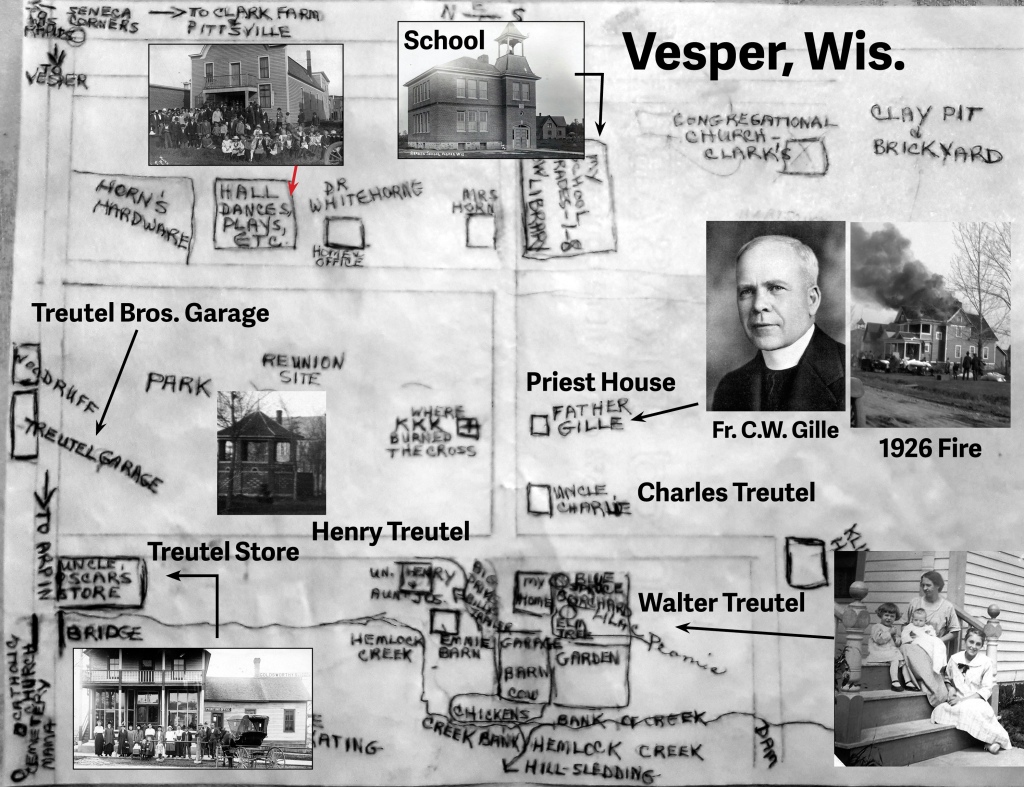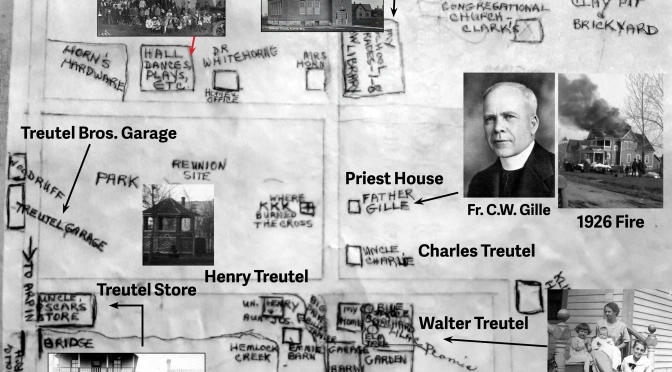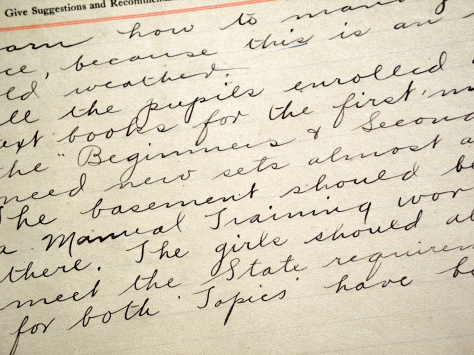The real estate surrounding Cameron Park in the tiny village of Vesper, Wisconsin, played an important role in the histories of the Hanneman and Treutel families. This village square was the nexus of commerce and family life at the dawn of the 20th century. It was home to a number of Treutel families, who came from Germany through Waukesha County seeking a new start.
A hand-drawn map made by Elaine (Treutel) Clark has surfaced that adds detail to how the town square was laid out and where the family homesteads sat more than a century ago. The map, likely drawn sometime in the 1980s, was provided to us by Elaine’s daughter, Mary Clark. Because all of the old Treutel homesteads in Vesper are now gone, the map provides missing detail on what the village looked like in the early 1900s.
As documented elsewhere on this site, the family of Johann Adam Treutel and the former Katharina Geier emigrated from Bremerhaven, Germany, to New York between 1849 and 1854. The family initially settled in Milwaukee before it began to branch out into other areas of Wisconsin and in the deep South of Louisiana, Alabama and Mississippi. Henrietta (Krosch) Treutel, the widow of Philipp Treutel, moved north with her children after Philipp died in 1891 near North Prairie, Wis.

Most of the Treutels lived on properties along Anderton Avenue in Vesper, along the western side of Cameron Park. Most also had their places of business along the same street, including a general store, a butcher shop and a smithy (blacksmith shop). The first of the Treutels to come to Vesper was Adeline B. (Treutel) Moody, who settled on a farm outside of the village. Her family was involved in the Moody-Hinze shootout incident.
In late 1898, Charles W. Treutel made a trip to Vesper to “look after his landed interests,” according to the Wood County Reporter. Charles and his brother Henry A. Treutel later established a blacksmith shop that eventually became a service station and auto-repair shop. Treutel Brothers was located on the Hemlock Creek, just across from the northern edge of Cameron Park.
The Treutels purchased what had been known as Goldsworthy’s store at the corner of Anderton and Cameron avenues. Oscar and Walter Treutel bought the store from C.R. Goldsworthy, one of the major land owners in the area. Oscar was the main proprietor, as Walter became a rural mail carrier for the U.S. Postal Service. The post office was originally located in Treutel’s store. Emma (Treutel) Carlin was the seventh postmaster of Vesper, starting her 11-year tenure in the fall of 1906. Just south of the Treutels’ general store was the butcher shop of Orville Carlin, Emma’s husband.
The map also shows the “priest house,” which was the home of Father C.W. Gille in April 1926 when a fast-moving fire leveled the building before firefighters could reach the scene. Carl Hanneman or wife Ruby (Treutel) Hanneman documented the fire in photographs. Father Gille presided at Carl and Ruby’s nuptial Mass on July 14, 1925 at St. James Catholic Church.
Along the east side of Cameron park we see a village hall, the location of a community gathering documented in an “Eye on the Past” feature on this web site. The building hosted a lot of functions over the years. For a time it was home to a roller rink operated by Harry Cole.

The southeast corner of the map shows the Vesper Graded School, where my grandmother, Ruby (Treutel) Hanneman went to school and later taught for a time after earning her teaching license. The well-built structure still stands, now serving as a private home.
The center of the park shows a bandstand, which many times was the center of activity with band and string concerts. The Vesper Cornet Band played in the park on more than a few occasions. The talented group of musicians included Charles Treutel, Henry Treutel and Orville Carlin, the husband of Emma (Treutel) Carlin.
Not far from the bandstand is an indicator where the Ku Klux Klan burned a cross sometime in the mid- to late 1920s. It was one of Elaine’s vivid memories from early childhood. We could find no reference to it in the Wisconsin Rapids papers. The Klan was certainly active during that time period. If this occurred before April 1926, it would have been directly across from the home of Father Charles W. Gille, the pastor of St. James Catholic Church.

Last but not least is the Walter Treutel homestead, along the western side of Cameron Park with its rear facing the Hemlock Creek. The Treutel children had lots of space to play in the field behind the house. The map says they went ice skating on the Hemlock Creek on winter days. We have many photos showing the home’s exterior, but no images from the inside of the house.

©2021 The Hanneman Archive









